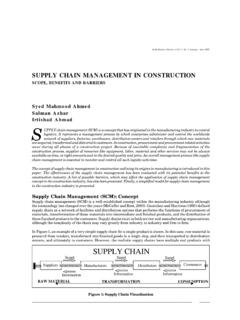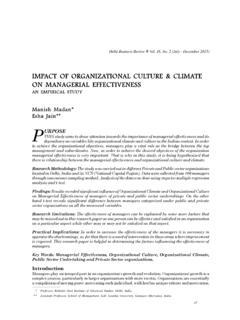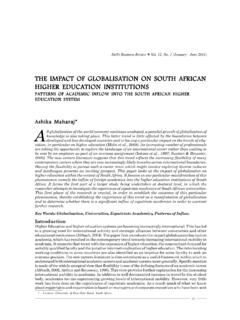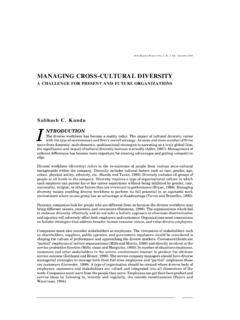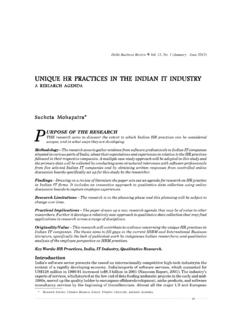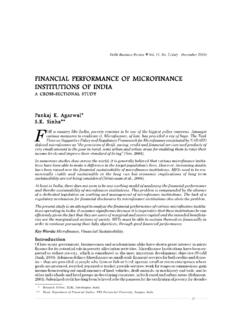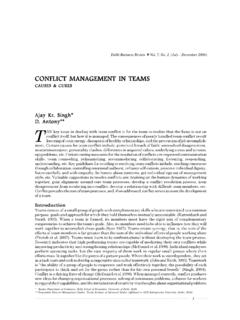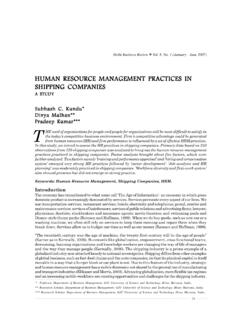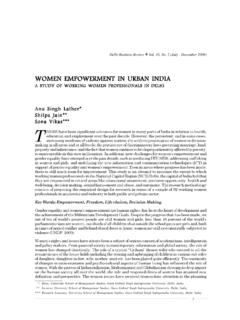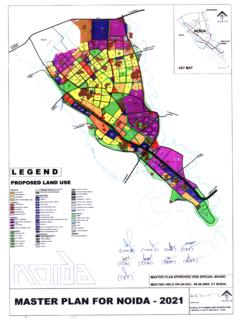Transcription of CHALLENGES FACING CHANGE MANAGEMENT THEORIES …
1 delhi Business Review X Vol. 9, No. 1 (January - June 2008)1 CHALLENGES FACING CHANGE MANAGEMENTCHALLENGES FACING CHANGE MANAGEMENTCHALLENGES FACING CHANGE MANAGEMENTCHALLENGES FACING CHANGE MANAGEMENTCHALLENGES FACING CHANGE MANAGEMENTTHEORIES AND RESEARCHTHEORIES AND RESEARCHTHEORIES AND RESEARCHTHEORIES AND RESEARCHTHEORIES AND RESEARCHM ildred Golden Pryor*Mildred Golden Pryor*Mildred Golden Pryor*Mildred Golden Pryor*Mildred Golden Pryor*Sonia Taneja**Sonia Taneja**Sonia Taneja**Sonia Taneja**Sonia Taneja**John Humphreys**John Humphreys**John Humphreys**John Humphreys**John Humphreys**Donna Anderson**Donna Anderson**Donna Anderson**Donna Anderson**Donna Anderson**Lisa SinLisa SinLisa SinLisa SinLisa
2 Singggggleton**leton**leton**leton**leto n**HANGE MANAGEMENT models and research are still relevant for the twenty-first century. Theproblems are not with their relevancy or their worth. The problems and CHALLENGES facingorganizational leaders, organizational development experts and researchers relate to the speedand complexity of CHANGE required today. This article addresses selected CHANGE MANAGEMENT modelsand research, their relevance in today s global economy and the CHALLENGES FACING organizationalleaders and researchers in terms of their application and expected results. We also suggest a relativelynew strategic model as well as new applications of existing CHANGE MANAGEMENT models and Words: CHANGE MANAGEMENT , Transformation, Organizational Transformation,Organizational CHANGE is constant and organizational leaders who anticipate CHANGE and react rapidly andresponsibly are successful.
3 However, the organizational leaders who anticipate and invent the futureare even more successful because those who invent the game are the leaders in their industry. Otherorganizations are followers that adapt to CHANGE . Still others are the organizations that do not are many models that can be used for successful organizational CHANGE . Winners respond to thepace and complexity of CHANGE . They adapt, learn and act quickly. Losers try to control and masterchange in the environment. It is important for organizational leaders to identify and use a model fortransformation that will help their organizations survive and flourish in the next century and article discusses and compares the components of various CHANGE models that have been (and canbe) used to react to and/or lead CHANGE versus Organizational TransformationOrganizational CHANGE has also been referred to as organizational development and organizationaltransformation (Cummings and Worley, 2005; Newhouse and Chapman, 1996).
4 Major differences inchanges today and those of previous eras are: (1) the simultaneous nature of the changes; (2) the speedat which the different types of CHANGE occur; (3) the complexity of changes, (4) the immediatecommunication and impact of the changes throughout the world; and (5) the need for individuals aswell as leaders of organizations and nations to step up and immediately make decisions and addressproblems, issues and resolution. There are significant differences in the types of CHANGE in terms ofC*Professor, Texas A&M University-Commerce, Box 3011, Commerce, Texas-75429, USA.**Lecturer, Texas A&M University-Commerce, Box 3011, Commerce, Texas-75429, USA.**Associate Professor, Texas A&M University-Commerce, Box 3011, Commerce, Texas-75429, USA.
5 **Lecturer, Texas A&M University-Commerce, Box 3011, Commerce, Texas-75429, USA.**Research Associate, Texas A&M University-Commerce, Box 3011, Commerce, Texas-75429, Golden Pryor, Sonia Taneja, John Humphreys, Donna Anderson, and Lisa Singleton2convergent and radical CHANGE as well as revolutionary and evolutionary CHANGE (Cummings and Worley,2005; Greenwood and Hinings, 1988; Kelly and Amburgey; Miller and Friessen, 1984; Mohrmann,Mohrmann, Ledford, Cummings and Lawler, 1989; Nadler, Shaw, Walton and Associates, 1995;Romanelli and Tushman, 1994). Radical organizational CHANGE or frame bending involves tearing loosefrom an existing orientation (Johnson, 1987; Miller, 1982; Miller and Friesen, 1982, 1984) andtransforming the organization (bending it toward another orientation).
6 Greenwood and Hinings (1996, ) note that convergent CHANGE is fine tuning the existing orientation. Because of the pace ofchange today, it is radical, not convergent CHANGE in which we are interested. Therefore, it is necessarytodefine CHANGE and organizational transformation in terms of the degree to which organizational changeoccurs as well as how rapidly the CHANGE occurs. Regardless of its speed, organizational CHANGE is themovement of an organization from the existing plateau toward a desired future state in order to increaseorganizational efficiency and effectiveness (Cummings and Worley, 2005; George and Jones, 2002).Figure 1: Adapting Organization Responding to ChangeSource: Adapted from Cateora and Graham (2002, ) and Pryor and Cullen (1993, )Such changes may be sporadic or ongoing, continuous improvement initiatives as a result of organizationsREACTING to external forces for CHANGE .
7 Changes like these may be a part of improvement initiativessuch as Total Quality MANAGEMENT and Six Sigma or Organizational Development initiatives based onvarious CHANGE models. Such CHANGE initiatives are worthwhile. Figure 1 depicts an organizationchanging in response to its domestic and global transformation is a radical movement that reflects widespread revitalization throughoutthe entire organization. Instead of an incremental strategy, organizational leaders adopt a radical, Organizational Environment (Controllable) Domestic Environment (Uncontrollable) Political/Legal Forces Competitive Structure Economic Climate Global Environment (Uncontrollable) Political/Legal Forces Economic Forces Cultural Forces Competitive Forces Geography and Infrastructure Distribution Structure Technological Forces Natural Disasters Terrorism Illiteracy Wars & Threats Of War Hunger & Disease Security Compromises & Identity Theft Violence in Families, Schools, Workplaces, Society Worldwide Electronic Communication Problems with Individual & Organizational Ethics & Integrity delhi Business Review X Vol.
8 9, No. 1 (January - June 2008)3fundamental CHANGE strategy whereby continuously learning and rapid reinvention are an integralpart of how they do business. They transform their respective organizations by developing (and deploying)new visions, missions, values, goals, strategies and structures that reflect a continuously-changingorganization and the capability for ongoing, radical self transformation and reinvention. In other words,transformed organizations CHANGE to such an extent that CHANGE becomes an on-going process and thenorm. Of utmost importance, the transformed organization PROACTIVELY drives innovation to theextent that it becomes a major force for CHANGE within the macro-environment as well. With thisdefinition of organizational transformation, the transformed organization is added to macro-environmentalforces along with technological advances, economic and political changes and other such forces (Beckhard,1997, 1969; Beckhard and Harris, 1982; Beckhard and Pritchard, 1992, Boeker, 1989; Cummings andWorley, 2005, Pettigrew, 1990; Pryor and Cullen, 1993; Pryor, White and Toombs, 1998; and Pryorand erson, Toombs and Humphreys, 2007).
9 Today s World of ChangeOrganizational leaders in this era are FACING CHANGE that is unprecedented in terms of type, quantity,speed, span/reach, cause, world-wide communication and implications, time available to address changesand expectations for performance results. Also, they must simultaneously think and make decisionsabout future CHANGE , some of which is long term and some of which is immediate (Cummings andWorley, 2005; Greenwood and Hinings, 1988; Kelly and Amburgey; Miller and Friessen, 1984; Nadler,Shaw, Walton and Associates, 1995; Romanelli and Tushman, 1994). This requirement of simultaneouslyplanning for the long term and the short term is not unique. What is unique is that organizationalleaders must now plan into the future 20 or more years whereas in the past, long term meant 3- to 5-year plans.
10 They must simultaneously plan for the short term which often means immediate responsesin 15 minutes instead of weeks or months. This also requires much more planning for , CHANGE happens to organizations instead of organizations being on the forefront of of actions and circumstances which impact private for-profit and not-for-profit organizationsas well as nations and which cause CHANGE include: Organizations and their employees are charged with illegalities (Burke, Polimeni and Slavin, 2007;Lindgreen, 2004; Doherty, 2007; Lindgreen, 2004; Heineman and Heimann, 2006). Economic conditions CHANGE as they are impacted by organizational failures, terrorist attacks,natural disasters, etc. (Caterinicchia, 2007; Johnson; 2002; Bram and Rapaport, 2002; May, 2006).

